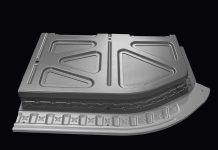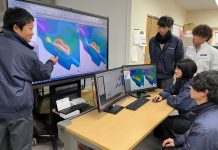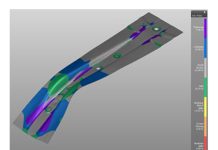Introduction
In the sheet metal forming industry, reducing CO2 emissions is increasingly imperative for two main reasons. First, to increase sustainability and convey a green company image. And second, to reduce future costs by purchasing less CO2 certificates, the price of which will increase every year.
CO2 reduction is a top priority at Volkswagen Group, as Mr. Stephan Krinke, Head of the VW Lightweight Program, asserts in this article published by Automobil Industrie. According to Mr. Krinke, Volkswagen considers the emission of greenhouse gas (GHG) along the entire product lifecycle. This means that all delivered components must have a positive CO2 balance to avoid costly compensation for the emissions later on.
One approach is to save material by decreasing the blank size, because every gram spared results in CO2 savings. Of course, other aspects also come into play here, like the robustness of the part production – see our blog post “Decreasing blank sizes to save money without any consequences?” You have to wonder that if a smaller blank leads to lower production stability due to a higher defect rate, then are we actually saving material in the end?
During the engineering phase, the goal of reducing the blank size should already be considered. One way to achieve this is through manual optimization, otherwise called the “trial-and-error approach”; however, a more systematic approach is generally preferred. A smarter way to optimize the blank size is to use a sensitivity analysis of the process parameters to narrow down the smallest blank size possible, which still provides robust results.
As an example, we’ll run such an analysis and see how much material, and consequently CO2, we can save by optimizing the blank of a structural part made of aluminum with a production volume of 2 million units.
Keep in mind that it takes 16 kWh of electrical energy, which produces 9 kg of CO2 emissions, to produce 1 kg of primary aluminum. That is around 550 liters at 1atm (atmosphere pressure) and 27°C – roughly the size of an SUV trunk.
We will evaluate the deep drawing operation of the stamping process that produces the structural part shown in Fig. 1 (cyan lines represent the part boundary), which is made of aluminum 6016 T4 with a thickness of 3mm.
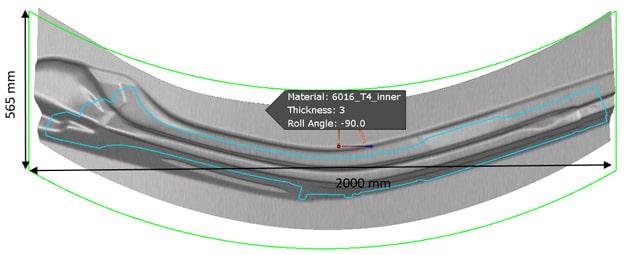
Fig. 1: Deep drawing result of the structural part
The starting point is represented by a stamping process that has been digitally validated with a blank having the size and shape shown in Figure 1.
Of course, the following constraints must be met for the optimization:
- The simulation has to fulfill all required limits for splits and wrinkles (no issues).
- Draw-In: At least 20mm must remain on the binder as draw-in control.
- Blank outline: The blank width is fixed at 2000mm (green line in Fig. 1). Target: Identify smallest possible blank outline.
Of course, for a more plausible and detailed calculation of CO2 emissions, additional steps could be taken into account like the transportation of the material from supplier to customer, stamping press line electric power, scrap rate (as already mentioned) and many others; but we’ll keep it as simple as possible for the sake of this example.
Let’s have a look at the results obtained by using a blank with dimensions of 2000x565mm, as shown in Figure 2.
So far, the engineering department has already obtained a feasible simulation result without splits and most of the draw-in satisfies the target. However, the wrinkle limits aren’t entirely fulfilled, as shown in Figure 2.
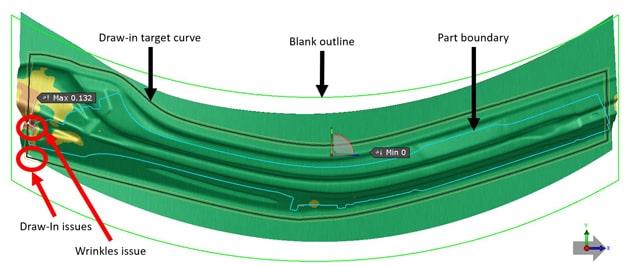
Fig. 2: Initial status – simulation showing issues
The results based on the current blank lead to the following output:
- Simulation fulfills all required limits for splits but wrinkles not fulfilled
- Draw-In: mostly fulfilled
- Blank outline: 2000 x 565mm
- Arc radius 3000mm à
The weight of the blank is 8.94 kg à CO2 emission per blank: 80.46 kg (143.04 kWh electrical energy). Note that this quantity roughly represents the capacity of 9 SUV trunks.
The Optimized Blank
Instead of trying to improve the blank outline by using a trial-and-error method, we apply a systematic approach by running a sensitivity analysis. Here are the variables with their related ranges:
- Blank size above in y-direction: ±35mm
- Blank size below in y-direction: ±35mm
- Arc with radius: between 2000mm and 3000mm
- Translation of the blank in y-direction: ±50mm
- Z-rotation: -5° – 0°
In running such an analysis, we also want to eliminate the minor issues shown in Figure 2; we’ll use the same analysis for two different purposes.

Fig. 3: The three most relevant draw-in areas to improve the blank outline
By using software capabilities, the blank outline is automatically optimized with respect to a target curve, which is positioned 20mm from the die entry curve. At the same time, all quality aspects are equally considered. The outcome of the analysis is deemed the improved blank.
The result of the sensitivity analysis to find the improved blank leads to the following output:
- Simulation fulfills all required limits for splits and wrinkles: Fulfilled
- Draw-In: Fulfilled
- Blank outline: 2000 x 489mm and the
- Arc with radius 28000mm,
- Blank position: y-translation = -21mm,
- z-rotation = 0°
With these newly configured parameters, the weight of the blank decreased to 8.06 kg à CO2 emission per blank: 72.54 kg (128.96 kWh electrical energy). This new quantity represents the capacity of 8 SUV trunks (thus, saving 1 SUV trunk of CO2 per blank).
Summary
Table 1 shows a direct comparison of the resultant CO2 emission to produce the required primary aluminum in both cases.

Table 1: Summary of the results for both blanks and criteria
As shown, it is possible to save 7.92 kg CO2 emission per blank and 15,840 t CO2 emission for the production of the primary aluminum of this single part by using the improved blank.
To gain a clearer picture, it’s helpful to understand that on average, a tree can store 10 kg CO2 per year.
Considering 8 years of production, targeting 2 million total units, we will have to produce 250,000 parts per year.
This means that 198,000 trees per year would be preserved from storing the CO2 emission for the primary aluminum production based on the material savings. That is equal to 270 football stadiums jam packed with trees!

Fig. 5: Putting things into perspective
Imagine the trees that could be further preserved if we took into account the transportation from the material supplier to the customer’s plant, the electric power required on the press line to produce the parts, and the scrap rate, along with many other operations.
Additionally, if we transfer this result to all sheet metal parts that must be manufactured for a single car body, the potential savings is huge. It is no big surprise then that many companies assign this objective to their top management.
However, economically speaking, how much money does reducing CO2 actually save companies?
Considering material savings only (0.88kg/blank) and that the cost of the aluminum is 80 eurocents per kg (0.8€/kg), the total savings (on 2M parts) is 1.4M€.
Is that all?
Well, if we consider the penalty fees for emitting CO2, assuming that we’re producing in Europe, where penalties for CO2 emissions average 25€/CO2 ton, there is an additional 400k€ saving.
From where I’m standing, it doesn’t look so paltry for investing just a couple days (or less) between simulation and post processing! What do you think?
What about your company? Are you already taking action to reduce your carbon footprint and energy consumption? And are you cashing in on the inherent money savings?





